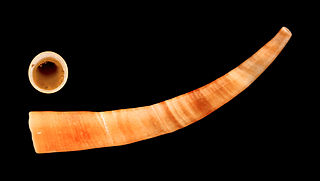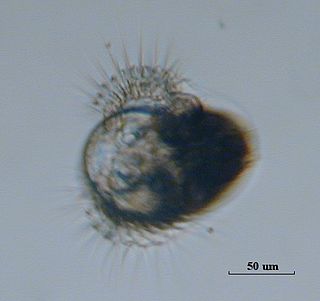
The tusk shells or tooth shells, often referred to by the more-technical term scaphopods, are members of a class of shelled marine mollusc with worldwide distribution, and are the only class of exclusively infaunal marine molluscs. Shells of species within this class range from about 0.5 to 15 cm in length. Members of the order Dentaliida tend to be significantly larger than those of the order Gadilida.
In anatomy, an apex is part of the shell of a mollusk. The apex is the pointed tip of the shell of a gastropod, scaphopod, or cephalopod.

The aperture is an opening in certain kinds of mollusc shells: it is the main opening of the shell, where the head-foot part of the body of the animal emerges for locomotion, feeding, etc.

A veliger is the planktonic larva of many kinds of sea snails and freshwater snails, as well as most bivalve molluscs (clams) and tusk shells.

Sculpture is a feature of many of the shells of mollusks. It is three-dimensional ornamentation on the outer surface of the shell, as distinct from either the basic shape of the shell itself or the pattern of colouration, if any. Sculpture is a feature found in the shells of gastropods, bivalves, and scaphopods. The word "sculpture" is also applied to surface features of the aptychus of ammonites, and to the outer surface of some calcareous opercula of marine gastropods such as some species in the family Trochidae.

Dentaliida is one of the two orders of scaphopod mollusks, commonly known as elephant's tusk shells. The order Dentaliida contains most of the larger scaphopods, and is distinguished from the other order by the shape of its shell, the shape of the foot, and the arrangement of some of their internal organs.
Carinodens is an extinct genus of Cretaceous marine lizard belonging to the mosasaur family. "Carinodens" means "keel teeth" and was named in 1969 as a replacement name for Compressidens, "compressed teeth", which was already in use for a gadilidan scaphopod mollusk.
The word dentalium, as commonly used by Native American artists and anthropologists, refers to tooth shells or tusk shells used in indigenous jewelry, adornment, and commerce in western Canada and the United States. These tusk shells are a kind of seashell, specifically the shells of scaphopod mollusks. The name "dentalium" is based on the scientific name for the genus Dentalium, but because the taxonomy has changed over time, not all of the species used are still placed in that genus; however, all of the species are certainly in the family Dentaliidae.

Dentaliidae is a family of relatively large tusk shells, scaphopod mollusks in the order Dentaliida.

Gadilida is an order of very small tusk shells, marine scaphopod molluscs.

Cadulus colubridens is a tusk shell or scaphopod in the family Gadilidae of the order Dentaliida. This species was described from only one specimen collected in 1874 by the H.M.S. Challenger expedition. The original description and a drawing was published in 1879 by Robert Boog Watson, a Scottish malacologist who reported on the Scaphopoda and Gastropoda of the Challenger expedition. The specimen was collected at a depth of about 1300 m in ocean waters east of North Island, New Zealand.
Dentalium glaucarena is a species of tusk shell, a marine scaphopod mollusk in the family Dentaliidae.
Ribeiria is a genus of rostroconch mollusc with a pegma, once interpreted as an intermediate between helcionellids and primitive scaphopods.
Entalinidae is a family of tusk shells, marine scaphopod mollusks in the order Gadilida.

Antalis is a genus of tusk shells, marine scaphopod mollusks.
Polyschides is a genus of gadilid scaphopod.
Siphonodentallidae is a family of scaphopods typified by Siphonodentalium and including fossil forms.
Prodentalium is a genus of fossil scaphopod assigned to the Dentalids, but on somewhat dubious grounds.
The Rhabdidae are scaphopod members of the same molluscan family, belonging to the order Dentaliida. It includes only one genus, Rhabdus, and five species, as follows:
Fustiaria is a genus of scaphopods in the order Dentaliida and is the only genus comprising the family Fustiariidae, with 24 species.







